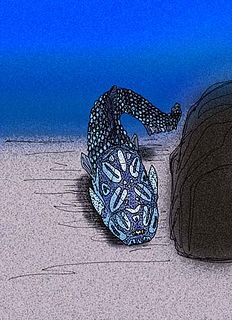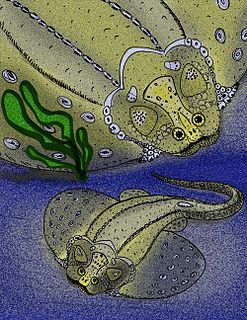
Gnathostomata are the jawed vertebrates. The term derives from Greek: γνάθος "jaw" + στόμα "mouth". Gnathostome diversity comprises roughly 60,000 species, which accounts for 99% of all living vertebrates. In addition to opposing jaws, living gnathostomes have teeth, paired appendages, and a horizontal semicircular canal of the inner ear, along with physiological and cellular anatomical characters such as the myelin sheaths of neurons. Another is an adaptive immune system that uses V(D)J recombination to create antigen recognition sites, rather than using genetic recombination in the variable lymphocyte receptor gene.

Pterichthyodes is a genus of antiarch placoderm fishes from the Devonian period. Its fossils have been discovered in Scotland. They were one of the first species recognized for what they were, as their fossils are common in the Old Red Sandstone formation studied by geologists in the early 19th century. Due to their extreme divergence from modern-day fish, they were a puzzle unsolved until Charles Darwin brought forward his theories on evolution.

Placodermi is a class of armoured prehistoric fish, known from fossils, which lived from the Silurian to the end of the Devonian period. Their head and thorax were covered by articulated armoured plates and the rest of the body was scaled or naked, depending on the species. Placoderms were among the first jawed fish; their jaws likely evolved from the first of their gill arches. Placoderms are thought to be paraphyletic, consisting of several distinct outgroups or sister taxa to all living jawed vertebrates, which originated among their ranks. This is illustrated by a 419-million-year-old fossil, Entelognathus, from China, which is the only known placoderm with a type of bony jaw like that found in modern bony fishes. This includes a dentary bone, which is found in humans and other tetrapods. The jaws in other placoderms were simplified and consisted of a single bone. Placoderms were also the first fish to develop pelvic fins, the precursor to hindlimbs in tetrapods, as well as true teeth. Paraphyletic groupings are problematic, as one can not talk precisely about their phylogenic relationships, characteristic traits, and complete extinction. 380-million-year-old fossils of three other genera, Incisoscutum, Materpiscis and Austroptyctodus, represent the oldest known examples of live birth. In contrast, one 2016 analysis concluded that placodermi are likely monophyletic.

Mizia is a genus of primitive antiarch placoderm found in Emsian-aged marine strata of Early Devonian China.

Panderichthys is a genus of extinct sarcopterygian from the late Devonian period, about 380 Mya. Panderichthys, which was recovered from Frasnian deposits in Latvia, is represented by two species. P. stolbovi is known only from some snout fragments and an incomplete lower jaw. P. rhombolepis is known from several more complete specimens. Although it probably belongs to a sister group of the earliest tetrapods, Panderichthys exhibits a range of features transitional between tristichopterid lobe-fin fishes and early tetrapods. It is named after the German-Baltic paleontologist Christian Heinrich Pander. Possible tetrapod tracks dating back to before the appearance of Panderichthys in the fossil record were reported in 2010, which suggests that Panderichthys is not a direct ancestor of tetrapods, but nonetheless shows the traits that evolved during the fish-tetrapod evolution

Bothriolepis was a widespread, abundant and diverse genus of antiarch placoderms that lived during the Middle to Late Devonian period of the Paleozoic Era. Historically, Bothriolepis resided in an array of paleo-environments spread across every paleocontinent, including near shore marine and freshwater settings. Most species of Bothriolepis were characterized as relatively small, benthic, freshwater detritivores, averaging around 30 centimetres (12 in) in length. However, the largest species, B. rex, had an estimated bodylength of 170 centimetres (67 in). Although expansive with over 60 species found worldwide, comparatively Bothriolepis is not unusually more diverse than most modern bottom dwelling species around today.
Pistosaurus is an extinct genus of aquatic sauropterygian reptile closely related to plesiosaurs. Fossils have been found in France and Germany, and date to the Middle Triassic. It contains a single species, Pistosaurus longaevus. Pistosaurus is known as the oldest "subaquatic flying" reptile on earth.

Rhenanida is an order of scaly placoderms. Unlike most other placoderms, the rhenanids' armor was made up of a mosaic of unfused scales and tubercles. The patterns and components of this "mosaic" correspond to the plates of armor in other, more advanced placoderms, suggesting that the ancestral placoderm had armor made of unfused components, as well.

Gemuendina stuertzi is a placoderm of the order Rhenanida, of the seas of Early Devonian Germany. In life, Gemuendina resembled a scaly ray with an upturned head, or a large-finned stargazer. G. stuertzi is often invoked as an example of convergent evolution- with its flat body and huge, wing-like pectoral fins it has a strong, albeit superficial similarity to rays. Unlike rays, however, both Gemuendina`s eyes and nostrils were placed atop the head, facing upward. Furthermore, G. stuertzi's upturned mouth would have enabled it to suction prey that swam overhead, rather than swallow sediment or suction prey out of the substrate like modern rays.

Antiarchi is an order of heavily armored placoderms. The antiarchs form the second-most successful group of placoderms after the arthrodires in terms of numbers of species and range of environments. The order's name was coined by Edward Drinker Cope, who, when examining some fossils that he thought were armored tunicates related to Chelysoma, mistakenly thought that the orbital fenestra was the opening for the mouth, or oral siphon, and that the opening for the anal siphon was on the other side of the body, as opposed to having both oral and anal siphons together at one end.

Acanthothoraci is an extinct group of chimaera-like placoderms who were closely related to the rhenanid placoderms. Superficially, the acanthoracids resembled scaly chimaeras, or (relatively) heavily armored ptyctodonts. They were distinguished from chimaeras by the presence of large scales and plates, a pair of large spines that emanate from their chests, tooth-like beak plates, and the typical bone-enhanced placoderm eyeball. They were distinguished from other placoderms due to differences in the anatomy of their skulls, and due to patterns on the skull plates and thoracic plates that are unique to this order.

The ptyctodontids ("folded-teeth") are placoderms of the order Ptyctodontida, containing the family Ptyctodontidae. With their big heads, big eyes, reduced armor and long bodies, the ptyctodontids bore a superficial resemblance to modern day chimaeras (Holocephali). Their armor was reduced to a pattern of small plates around the head and neck. Like the extinct and related acanthothoracids, and the living and unrelated holocephalians, most of the ptyctodontids are thought to have lived near the sea bottom and preyed on shellfish.

Quasipetalichthys haikouensis is a species of extinct petalichthid placoderm from the Middle Devonian of China.
Doleserpeton is an extinct, monospecific genus of dissorophoidean temnospondyl within the family Amphibamidae that lived during the Upper Permian, 285 million years ago. Doleserpeton is represented by a single species, Doleserpeton annectens, which was first described by John R. Bolt in 1969. Fossil evidence of Doleserpeton was recovered from the Dolese Brothers Limestone Quarry in Fort Sill, Oklahoma. The genus name Doleserpeton is derived from the initial discovery site in Dolese quarry of Oklahoma and the Greek root "serp-", meaning "low or close to the ground". This transitional fossil displays primitive traits of amphibians that allowed for successful adaptation from aquatic to terrestrial environments. In many phylogenies, lissamphibians appear as the sister group of Doleserpeton.

Incisoscutum is a genus of arthrodire placoderm from the Late Frasnian Gogo Reef, from Late Devonian Australia. The genus contains two species I. ritchiei, named after Dr. Alex Ritchie, a palaeoichthyologist and senior fellow of the Australian Museum, and I. sarahae, named after Sarah Long, daughter of its discoverer and describer, Dr. John A. Long.
Antlerpeton is an extinct genus of early tetrapod from the Early Carboniferous of Nevada. It is known from a single poorly preserved skeleton from the Diamond Peak Formation of Eureka County. A mix of features in its compound vertebrae suggest that Antlerpeton is a primitive stem tetrapod that has affinities with later, more advanced forms. Its robust pelvis and hind limbs allowed for effective locomotion on land, but the animal was likely still tied to a semiaquatic lifestyle near the coast.

Vukhuclepis lyhaoensis is an extinct, primitive antiarch placoderm. Specimens are of mostly complete thoracic armor from the Early Devonian Lyhao Formation in Vietnam. The armor is very similar to that of Yunnanolepis, but is distinguished by a unique pattern of raised ridges radiating from a point at the center of the dorsal shield of the thoracic armor. A similar, albeit more floral-looking pattern is seen in the Chinese Mizia. V. lyhaoensis' armor is further ornamented with small tubercles.
Microbrachius is an extinct genus of tiny, advanced antiarch placoderms closely related to the bothriolepids. Complete articulated specimens show that the armored section of the body had an average length of 2-4 cm. Species of Microbrachius are characterized by having large heads with short thoracic armor. Specimens of Microbrachius have been found in Scotland, Belarus, Estonia, and China. Specimens range in age from the Lower Devonian Late Emsian Stage to the Middle Devonian Upper Givetian Stage.

Romundina is a small, heavily armored extinct genus of acanthothoracid placoderms which lived in shallow marine environments in the early Devonian (Lochkovian). The name Romundina honors Canadian geologist and paleontologist Dr. Rómundur (Raymond) Thorsteinsson of Calgary, Alberta, Canada. Romundina are believed to have lived on Earth between 400 and 419 million years ago. The closest known relative to Romundina is the acanthothoracid Radotina. The type and only described species is R. stellina.

Asterolepis is an extinct genus of antiarch placoderms from the Devonian of North and South America and Europe. They were heavily armored flat-headed benthic detritivores with distinctive jointed limb-like pectoral fins and hollow spine. The armor plate gives the Asterolepis a box-like shape. Its pectoral fins are also armored but the caudal and dorsal fin are not. The first fossils were named by M. Eichwald in 1840 after noticing star-like markings on the fossils.
















